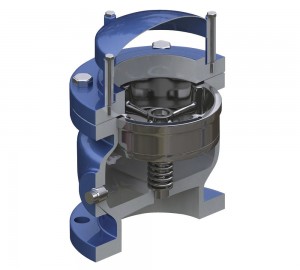APCO Vacuum Relief/Air Inlet Valves (AVR)
Design Features:
APCO AVR 1500A Vacuum Relief/Air Inlet Valves are proven reliable at preventing vacuum formation in pipelines and resulting damage from column separation and water hammer (pressure surges). They are normally closed, large orifice one-way valves. They permit air to enter the pipeline or system to break a vacuum, but no air escapes when the system pressure returns to positive. They are available in sizes 3-24” (80-600mm) and are recommended for either water or sewage applications.
The AVR is also available as a 1500AC Combination Valve, with the large orifice Vacuum Relief/Air Inlet Valve opening quickly to prevent a vacuum while the small orifice Air Release Valve regulates a slow discharge of air from the pipeline.
Vacuum Relief/Air Inlet Valves are normally shut for prolonged periods of time, and often not readily accessible for inspection. Therefore, it is critically important to select a reliable, high quality valve. The APCO AVR Vacuum Relief/Air Inlet Valve consists of the highest quality components: body, cover, plug, seat, stainless steel spring, and a hood or cap to prevent debris from entering the valve.
The ruggedly constructed globe type body has integrally cast flanged ends in ASME 125/150 and ASME 250/300 (3-12"); 80-300mm pressure classes. The Vacuum Relief/Air Inlet Valve is cast ductile iron; for more demanding applications, carbon steel or 316 stainless steel bodies are available. Ductile iron bodies are flat faced as standard; carbon steel and stainless steel are raised face as standard.
The internal valve plug and seat are 316 stainless steel for durability and corrosion resistance. The plug is center guided on both ends to provide drop tight shut-off and prevent jamming. The plug is held in the normally closed position by a precisely coiled and annealed stainless steel spring and bushing.
The resilient seat is retained in the body by the cover. The seat is designed to prevent distortion and provide positive shut-off. Resilient seat options include Acrylonitrile-Butadiene (NBR), Ethylene Propylene & A Diene (EPDM) and Fluoro Rubber (FKM).
The Vacuum Relief/Air Inlet Valve has a steel hood to prevent debris entering on sizes 6-24” (150-600mm) and a mushroom cap on sizes 3" & 4” (80 & 100mm). Optional bug or rock screens are available.
The Vacuum Relief/Air Inlet Valve is normally closed. Should the system pressure become negative, the Vacuum Relief/Air Inlet Valve will immediately admit air into the system and prevent a vacuum from forming. When system pressure returns to positive, the Vacuum Relief/Air Inlet Valve closes air tight.
The valve has a cross-sectional inflow area that is 10% greater than equivalent pipe size for full vacuum relief protection during draining, pipeline rupture or water column separation. Standard Vacuum Relief/Air Inlet Valves are designed to open with a minimal 0.25 psi (2 kPa) pressure differential across the orifice. Higher or lower relief settings are available on application.
Vacuum Relief/Air Inlet Valves are installed at high points on a pipeline or a tank. They can also be installed at level points on a pipeline where it has been determined a vacuum may occur. A vacuum condition can be sufficient to collapse a thin wall pipeline or a sealed water tank.
Vacuum conditions cause water column separation to take place resulting in water hammer (pressure surge) when the water column rejoins. The severity of damage due to water column separation and resulting pressure surges in a pipeline when the column rejoins, will generally cause greater damage than the initial vacuum condition. To prevent damage from water hammer, a large orifice Vacuum Relief/Air Inlet Valve can be combined with a small orifice Air Release Valve as a Combination Valve.
The large orifice Vacuum Relief/Air Inlet Valve can be combined with a small orifice Air Release Valve to prevent damage from water hammer.
When installed at points where water column separation is anticipated, the large valve will open due to vacuum, admitting air into the pipeline which fills the void created by water separation. It will then instantly close, trapping air which will be compressed and act like brakes to slow down the rejoining water column and minimize severe pressure surge as system pressure returns to positive. Meanwhile, the small orifice Air Release Valve has also opened due to vacuum and stays open regulating a slow discharge of air from the pipeline to enable a gradual return to normal pipeline system operating pressure without damage.
Vacuum Relief/Air Inlet Valves (AVR) Specifications
BODY MATERIAL:
Ductile iron, carbon steel, 316 stainless steel
PRESSURE RATING:
ASME 125/150 and 250/300 class
SIZE RANGE:
3-24” (80-600 mm)





